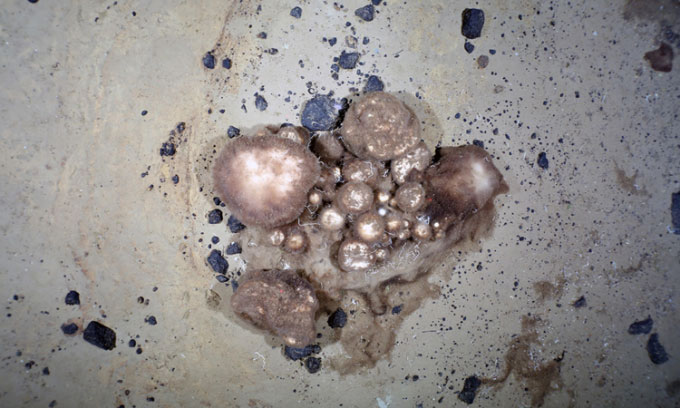Discovered a 300-year-old sponge garden 15km2 wide on the seabed
Thousands of sponges grow in ancient underground volcanoes under the Arctic Ocean by absorbing compounds abundantly from dead sea creatures.
Scientists discovered the sponge garden at Langseth Ridge, part of an ancient underground volcano in the Central Arctic Ocean, at a depth of 500 to 600 meters, where temperatures are just a little above freezing. Specifically, they found thousands of sponges covering an area of 15 square kilometers.
In some nutrient-scarce deep seas, seafloor ecosystems are often concentrated around hydrothermal vents. These vents can provide heat and food, but volcanic activity in this part of the mountain stopped thousands of years ago. There are also no strong currents that carry food for the sponges from above or below.

Sponge gardens have an average age of 300, some even more ancient.
However, sponges have discovered a rich and abundant food source: dissolved compounds from a graveyard of tubeworms and bivalves that died long ago. They digest these substances with the help of symbiotic bacteria.
The scientists used a network of cameras and sensors called the "Ocean Bottom Observation and Depth Measurement System" to video, take pictures and collect other data about the sponge garden. They also collected samples of sponges and their environment using a remotely operated diving robot called "Nereid Under-Ice". The new study was published in the journal Nature Communications on February 8.
Of the thousands of sponges that gather around the summits of underground volcanoes, many have even grown to enormous sizes with a diameter of 1 meter, according to Teresa Morganti, a postdoctoral researcher at the Max Planc Institute and lead author of new research. Many sponges are also actively spawning.
Under the sponge garden, the team found a thick layer of biomass mainly made up of tubes left behind by sea worms. These worms died when the underground volcano stopped working about 2,000 - 3,000 years ago.
Traces of sponges on fossils show where they used to feed before "settling" above the biomass. Many sponges are at least 300 years old and contain diverse microorganisms. The phylum Chloroflexi can play an important role in decomposing fossil tubeworms and releasing dissolved organic matter for sponge food.
If sponges have been here for centuries and now have thousands, is their food supply in danger of running out? Morganti thinks the answer is probably no because sponges' metabolic rates are exceptionally slow.
"These are large individuals that live in the Central Arctic Ocean, where the temperatures are very cold, so their metabolisms are generally extremely low. They don't consume this food very quickly. So I assume that's the case." they still have a lot of food," she explained.
However, even if food sources don't run out quickly, climate change could still pose more immediate threats to sponge survival. The sea above Langseth Ridge is often covered with ice. But as the Arctic warms and the sea ice on the surface melts, more nutrients will drift from the sea surface to the mountains below. If deep-sea food becomes more abundant, other marine species could move down there and disrupt the sponge's deep-sea habitat, Morganti said.
- The sponge 'forest' at a depth of 2,000m below the US seabed
- Egypt reveals the tomb ruins of nearly 4,000 years old
- Video: Detecting a harp-like sponge
- 3800 year old potato garden excavation
- Everyone likes to squeeze this sponge, but you will be shocked to know its true purpose
- Highway replica hanging garden Babylon nearly intact after 2000 years
- Eel bends like a hair at the bottom of the sea
- Canada started drawing seabed maps around the North Pole
- Black garden ants have their own 'toilet' in the nest
- The unidentified yellow sponge filled the French beach
- Seabed survey in the earthquake area in Japan
- Flowers blooming in the world's largest garden
 Surprised: Fish that live in the dark ocean still see colors
Surprised: Fish that live in the dark ocean still see colors Japan suddenly caught the creature that caused the earthquake in the legend
Japan suddenly caught the creature that caused the earthquake in the legend A series of gray whale carcasses washed ashore on California's coast
A series of gray whale carcasses washed ashore on California's coast Compare the size of shark species in the world
Compare the size of shark species in the world